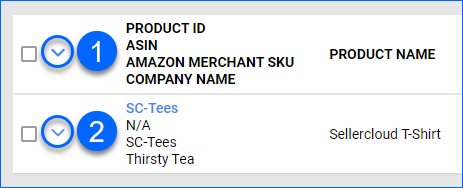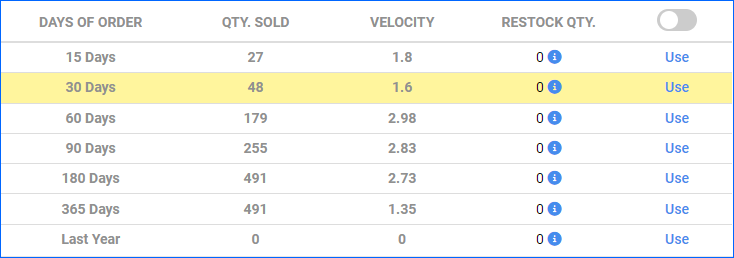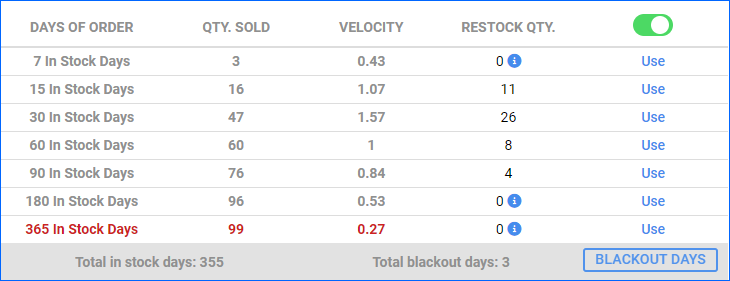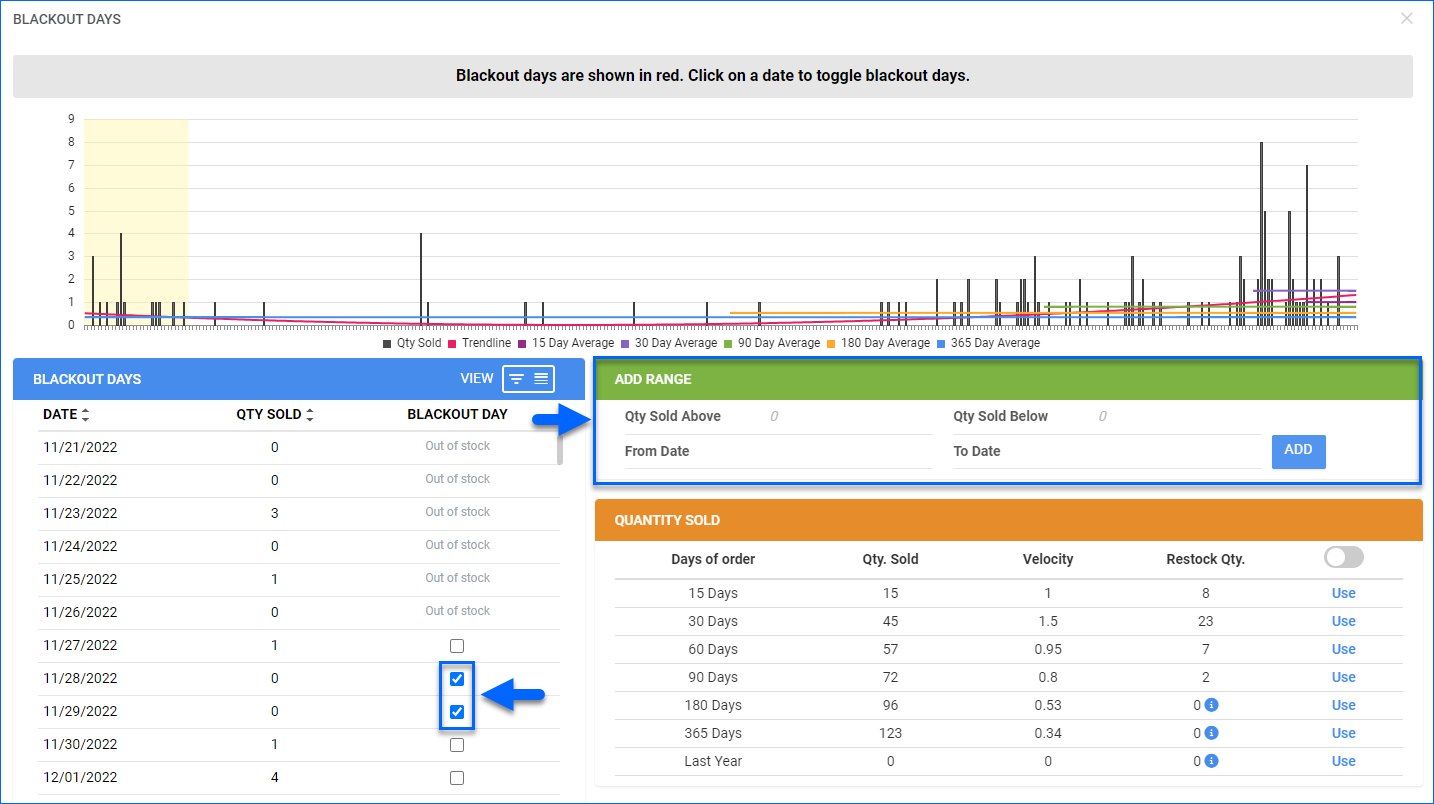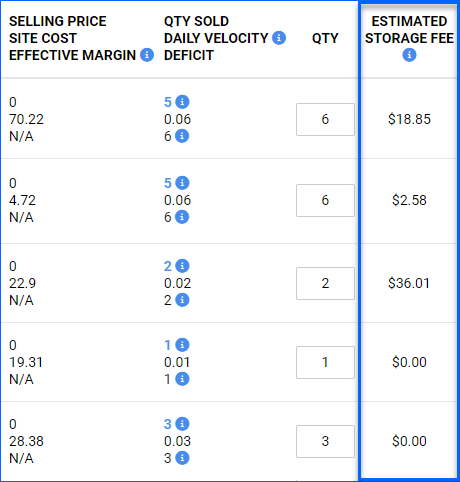Overview
Predictive Restocking for FBA calculates the quantity of products needed to be restocked at FBA to meet the expected volume of FBA orders for a range of days. This feature is similar to Predictive Purchasing but is focused on the selling SKU and the amounts needed to restock FBA. It is not designed to provide information about the inventoried SKU or determine purchase quantities. Restocking FBA relates only to the actual SKU sold on FBA.
The service ProductQtySoldCalcuateServices must be running on the server. This can be enabled by Sellercloud Support.
Before you read this article, learn more about the related client settings in the Predictive Purchasing Tools article.
Key Terms
| TERM | DEFINITION |
| Days OF Order | Days of past sales from which you are basing the prediction. This generates a daily velocity. Days with no stock availability will be skipped in the Days Of Order Count. |
| Days TO Order | Days to which you are multiplying the daily velocity to generate an Add to FBA Qty. While the deficit supply will be calculated for all dates, this selection lets you perform a quick add to FBA. See below. |
| Velocity | Rate of sales per day when calculated by – Qty Sold in Days of Order divided by Days of Order |
| Deficit | The predicted deficit to your supply for multiple date ranges. This is calculated as follows: (Velocity x Deficit Days) – (FBA Available Qty + In Transit + FBA Unshipped). See the terms below:
|
After determining the quantity to send, you can add to an FBA inbound shipment directly from this page.
Example: Days of Order 30/ Days To Order 60

Predictive Restocking Example
In this example, 69 units were sold from FBA in the past 30 days. Because it is based on a 30-day period, the per-day velocity is 2.3.
- Deficit 15 — Multiplying 2.3 by 15 = 34.5. Subtract the FBA Qty, the Unshipped Qty, and the In Transit Qty. This gives you a Deficit 15 of 0.
((69/30) * 15) – (12 + 29 + 21) = – 27.5. Therefore, there is no deficit quantity. - Deficit 30 — Multiplying 2.3 by 30 = 69. Subtract the FBA Qty, the Unshipped Qty, and the In Transit Qty. This gives you a Deficit 30 of 7.
((69/30) * 30) – (12 + 29 + 21) = 7 - Deficit 60 — Multiplying 2.3 by 60 = 138. Subtract the FBA Qty, the Unshipped Qty, and the In Transit Qty. This gives you a Deficit 60 of 76.
((69/30) * 60) – (12 + 29 + 21) = 76 - Same calculation for 45 and 90
- Since Days To Order 60 was selected, the deficit qty of 76 is auto-entered into the Qty field to add to an FBA Inbound Shipment.
The following features were recently added to FBA restocking to help you determine products to restock:
- FBA Reserved Qty — Quantity reserved by FBA orders
- Amazon Rank — This Sales Rank calculation is based on Amazon sales and is updated daily to reflect recent and historical sales of the item sold on Amazon. Lower numbers indicate a higher ranking. You can get the current sales rankings from the Action menu.
- Effective margin after Amazon fees — Subtracts the estimated fees from the price to give you an idea of your revenue margins. You can then compare this to the site cost, which is visible on the same page, to see your profit margins for the product.
Generate Restock Predictions
Sellercloud’s Predictive Restocking feature provides the following additional information and capabilities:
- Considers quantities already in transit to FBA.
- Considers quantities already in FBA inbound shipments that have not yet been shipped.
- Can filter products to only show products with inventory in your warehouse to add to FBA.
- Can filter products by SKU, vendor, buyer, manufacturer, product group, velocity range, and more.
Before you generate Restock Predictions, do the following:
- Enable the Calculate Qty Sold in X days for Predicted Purchasing client setting.
- Ensure that ProductInventoryMovementServiceis running on the server. It runs daily at around 2:00 AM.
To generate Restock Predictions:
- Go to Purchasing > Tools > Predictive FBA Restocking.
- Optional: If the requirements above are not met, or if you want to calculate based on even more recent data, press Action menu > Generate Data for Sold Since Last Year > Go. This will calculate data for all FBA products in your catalog. (Alternatively, you can select specific items on the grid and press Action menu > Generate Data for Selected SKUs. SKUs will only appear in the grid after steps 3 and 4 are completed.)
- Select Days of Order and Days to Order.
- Filter search as needed and click Search to populate the grid with items in the columns shown in the accordion below. The grid will only show items Fulfilled by Amazon.

| COLUMN | DEFINITION |
| ProductID | SKU |
| Preview Image | Displays the first image in the product’s Image Manager. |
| Parent Product ID | If the item is a shadow, it will show the shadow parent product ID (FBA SKUs are often shadows). |
| Product Name | The formal title of the product. |
| ASIN | Amazon standard identification number. |
| Site cost | The cost/expenses for the product. |
| Selling Price | Price on the Amazon Health report often differs from the defined Amazon price in Sellercloud.
If none is found, we will use the seller-defined Amazon Price on the Amazon Properties page. |
| Buy Box Price | The retail price of the BuyBox on Amazon. Many online sellers will use this information to determine if they can be competitive on a given product or if they should discontinue the product. Read how to get the Amazon BuyBox here. |
| Amazon Rank | How well a listing is selling compared to other listings in the same category. |
| Avail. Local Quantity | Quantity in all sellable warehouses available to be added to an FBA inbound shipment. This excludes the FBA warehouse, even if the FBA warehouse is sellable. Hover over the tooltip for a per-warehouse breakdown of your available local inventory.
See below for available qty related to kits.
Available quantity can be limited to a specific warehouse.
|
| FBA Qty | The current FBA quantity available for sale at FBA. |
| FBA Reserved Qty | By default, Sellercloud will only import the quantity reserved because it has been ordered by a customer. |
| Qty | Quantity available to be added to FBA. |
| Effective Margin After Amazon Fee | Calculates profit margin after fees are deducted: Amazon Price – FBA Fees – Item cost = Margin. Hover over the number to reveal the breakdown. The effect margin percent is calculated against the item cost as such: Margin$/cost * 100). |
| FBA Sellers | The number of sellers on that ASIN that are fulfilling their inventory through FBA. |
| Velocity | Rate of sales per day. This is calculated as Qty Sold in Days of Order divided by Days of Order. |
| Qty Sold 3 | The quantity sold from FBA in the selected Days of Order. Based on the Client Setting above, it will calculate sales of on-days inventory availability. This means days within the selected Days of Order where there was no available inventory at FBA will be skipped in the count. |
| Deficit 7 | The predicted deficit to your supply at FBA. This is calculated as follows: (Velocity x Days To Order) – (FBA Qty + In-Transit Qty + FBA Unshipped) = Deficit Qty |
| Deficit 11 Mo | Quantity Sold 11 months prior for a full month period.
This is helpful when trying to determine quantities to add to FBA for seasonal periods, which are often different than preceding non-season months. For example, if you are at the start of November and want to determine how much to add to FBA for the coming seasonal month of December, this column will look back 11 months – to December of the previous year – and show the quantity sold for the month of December. This can be used as an indicator if you need to add more quantity than was calculated based on the regular velocity. |
| In Transit | FBA Inbound shipped but not yet received. |
| FBA Unshipped | The current quantity has already been added to an FBA inbound shipment that has not been shipped. |
| Vendor | The default vendor on the product. |
| Available Qty for Kits | Kits being added to FBA must have an Independent inventory status. This means that its inventory quantity is independent of the inventory quantity of the components. The independent kit gets inventory by assembling the kit. Therefore, by default, the available quantity shown on a kit item will only be what has already been assembled into the independent kit. Hovering over the Available Qty will open a window that shows the breakdown with the following terms:
|
| Storage Type | Your product’s storage type. You can set storage types on Amazon, such as standard-size, oversize, apparel, footwear, flammable, aerosol, and extra-large.
*Available only when exporting the report to a spreadsheet from Sellercloud’s Alpha interface. |
Customize Columns
You can customize the columns that appear in your search results.
To make changes to the columns:
- Click on the vertical ellipsis menu at the upper-right corner > Customize Columns.
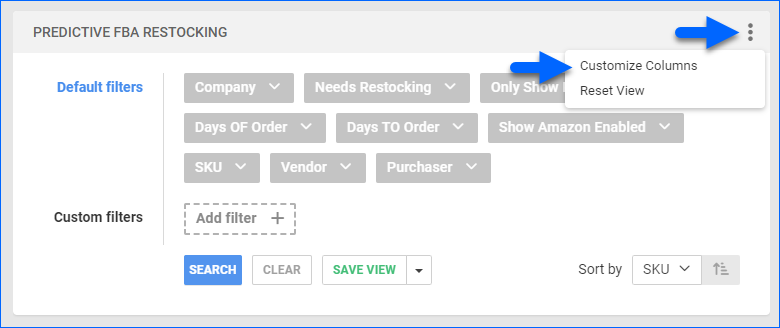
- A new window will appear containing the default columns and additional columns that you can add. Click Add column and scroll or type the name in the Search field.
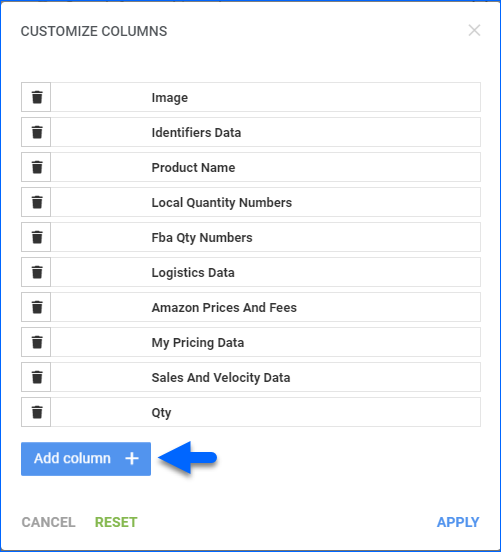
- Optional: Select a column by your choice > Apply to save the changes.
- Optional: Click Cancel to abort action or click on Reset to get back to the default columns setting.
If sellers view the reserved quantity in Predictive Restocking, the Always Consider FBA Total Supply Quantity client setting must be enabled. Otherwise, the reserved quantities will be subtracted from the Available Qty twice.
Export Predictive Restocking Reports
You can create a scheduled task that automatically exports a predictive restocking Excel file to email or FTP. You can save the Excel file for future reference and documentation.
To export a predictive restocking report:
- Go to Purchasing > Predictive FBA Restocking > Search > Select the items you want.
- From the Action menu, select Export To Excel.
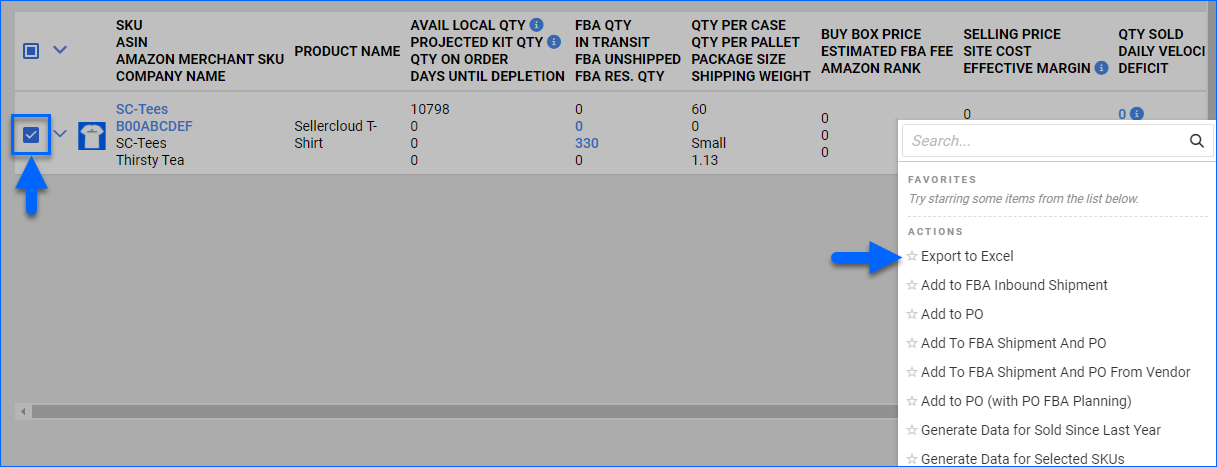
Add to an FBA Inbound Shipment
If you’re selling products on any marketplace, you can use Amazon’s Fulfilled by Amazon (FBA) service to fulfill orders through Amazon. This saves time and can help grow your business by removing the burden of order logistics and fulfillment. The FBA service will handle the picking, packing, shipping, and customer service.
After your search results are displayed, follow the instructions below to add a product to an FBA inbound shipment:
- Select the products on the grid.
- Enter the amount you want to order in the Qty text field.
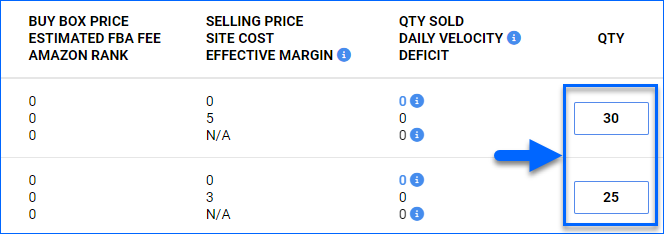
- Click the Actions icon and select Add to FBA Inbound Shipment.
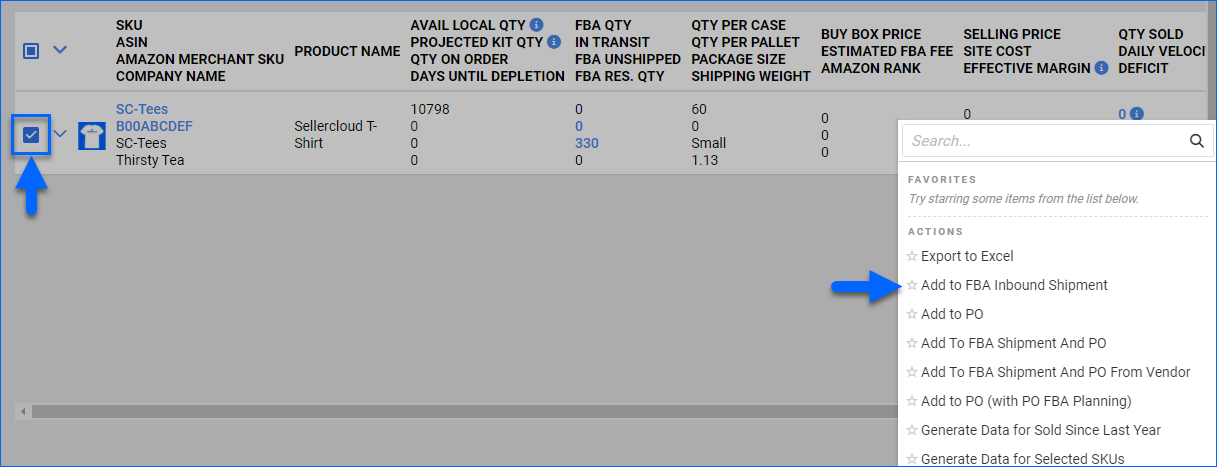
- You will be prompted to create a new FBA Shipment or add to an existing shipment. Choose your option and click Continue.
Enhanced FBA Restocking Report
You can enable an enhanced version of the report to add more features.
The enhanced version has a new column and a Level 2 that you can expand per line or for all items simultaneously to see the new features.
To show or hide Level 2, click:
- (1) The Down Arrow next to the column headers on top for all items.
- (2) The Down Arrow next to each row for a single item.
Sales Graph
The Sales Graph shows the daily sales for the last 365 days. You can see the following:
- Orders – The number of orders for each day.
- Trendline – The sales trend over time.
- Averages – The average sales Velocity for different Days OF Order periods. To hide lines, click the colored squares.
- Last Year – The selected Days OF Order time period during the previous year is highlighted in yellow.
Velocities Chart
The Velocities Chart shows the Quantity Sold, Sales Velocity, and Restock Quantity for multiple Days OF Order periods. The period you initially selected when generating the report will be highlighted in yellow. To apply the Restock Quantity for another period, click Use, and it will populate in Level 1 of the report.
You can switch the Days OF Order type between In Stock Days and Calendar Days with the toggle button. The default type comes from the Client Setting Use InStock days in predictive purchasing data. For In Stock Days below 365, the font will be red, indicating a projected velocity that is not fully based on real sales history.
If you choose to show the Calendar Days, you will also see the Last Year row, which gets the data for the selected Days OF Order starting from today’s date on the previous year. For example, if you set the Days OF Order to 30 on July 9th, it will check the 30 days after July 9th of the previous year.
If you show the In Stock Days, you can click the Blackout Days button next to the Sales Graph to open the blackout days window.
The Blackout Days feature allows you to exclude specific days, entire date ranges, or sale quantities above or below specific numbers from the calculation. For example, if there was a sales spike or no sales, you can exclude these days so they don’t skew your restocking numbers incorrectly. Blackout days are shown in red in the Sales Graph.
- In the Blackout Days grid, you can check the box under the Blackout Day column to exclude any day from the calculation.
- In the Add Range grid, you can specify a From Date and To Date to exclude a whole date range or enter a Qty Sold Above and/or Qty Sold Below to exclude specific sale quantities.
- The Last Year period is highlighted in yellow.
Estimated Storage Fees
The Estimated Storage Fee column shows a rough estimate of the FBA Storage Fee if the Qty gets sold in the selected Days TO Order, taking into account:
- Product Size Tier – Standard-size, Oversize, and Dangerous goods
- High/Low Season – High (October – December) and Low (January – September)
Understanding predictive restocking
Predictive restocking for FBA calculates the quantity of products needed to be restocked at FBA to meet the expected volume of FBA orders for a range of days.
While Amazon provides a restock report, their report is only based on the current inventory at FBA versus the past quantity sold at FBA. This may be an inaccurate restock quantity because it lacks information about quantities added to FBA or reserved for FBA that have not yet been previewed.
Additionally, the Amazon report includes all items, while you may want to focus on a narrower group of products.
Sellercloud’s predictive restocking provides the following additional information and capabilities:
- Considers quantities already in-transit to FBA
- Considers quantities already in FBA inbound shipments that were not yet shipped
- Can filter products to only show products with inventory in your warehouse to add to FBA
- Can filter products by SKU, vendor, buyer, manufacturer, product group, velocity range, and more.
This feature is similar to Predictive Purchasing but is focused on the “selling” SKU and the amounts needed to restock FBA. It is not designed to provide information about the “inventoried” SKU and determine purchase quantities.
For example, if a product has many shadows, predictive purchasing can factor in sales for all related shadows of the purchasing SKU (SKU used on the PO) because inventory is maintained by that SKU. Restocking FBA relates only to the actual SKU sold on FBA.
| TERM | DEFINITION |
| Days OF Order | Days of past sales from which you are basing the prediction. This generates a daily velocity. Days with no stock availability will be skipped in the Days Of Order Count. |
| Days TO Order | Days to which you are multiplying the daily velocity to generate an Add to FBA Qty. While the deficit supply will be calculated for all dates, this selection enables a quick add to FBA. See below. |
| Velocity | Rate of sales per day when calculated by – Qty Sold in Days of Order divided by Days of Order |
| Deficit Supply | The predicted deficit to your supply for multiple date ranges. This is calculated as follows: (Velocity x Deficit Days) – (FBA Available Qty + In-transit + FBA Unshipped). See the terms below:
|
After determining the quantity to send, you can add to an FBA inbound shipment directly from this page.
Example: Days of Order 30/ Days To Order 60
In this example, 69 units were sold from FBA in the past 30 days (as seen in the Qty Sold field). Because it is based on a 30-day period, the per-day velocity is 2.3.
- Deficit Supply 15— Multiplying 2.3 by 15 = 34.5. Subtract the FBA Qty, the Unshipped Qty, In-transit Qty. This gives you a Deficit 15 of 0.
((69/30) * 15) – (12 + 29 + 21) = – 27.5. Therefore, there is no deficit qty - Deficit Supply 30— Multiplying 2.3 by 30 = 69. Subtract the FBA Qty, the Unshipped Qty, In-transit Qty. This gives you a Deficit 30 of 7.
((69/30) * 30) – (12 + 29 + 21) = 7 - Deficit Supply 60— Multiplying 2.3 by 60 = 138. Subtract the FBA Qty, the Unshipped Qty, In-transit Qty. This gives you a Deficit 60 of 76.
((69/30) * 60) – (12 + 29 + 21) = 76 - Same calculation for 45 and 90
- See below for an explanation of 11/M
- Since Days To Order 60 was selected, the deficit qty of 76 was auto-entered into the Qty field to add to an FBA Inbound Shipment. See below.
Recently added to FBA restocking to help you determine products to restock:
- FBA Reserved Qty— Quantity reserved by FBA orders
- Amazon Rank— This Sales Rank calculation is based on Amazon sales and is updated daily to reflect recent and historical sales of the item sold on Amazon. Lower numbers indicate a higher ranking. You can get the current sales rank from the Action menu.
- Effective margin after Amazon fees— Subtracts the estimated fees from the Price to give you an indication of your revenue margin. You can then compare it to the site cost, which is visible on the page, to see your profit margins for the product.
- Num FBA Sellers— The number of sellers with FBA offers that are in New condition.

| SETTING | DEFINITION |
| Predictive Restocking: enable for purchasing | The setting Reduce OnOrder Qty will display on the Predictive Restocking for FBA page. The OnOrder qty will be subtracted from the Qty To Order text box. This option is typically used if you want to create a PO from this page and order from a vendor specifically to restock on FBA. |
| Predictive Restocking: Consider FC Transfer and FC Processing as reserved |
FC transfer or FC processing means that Amazon places a reserve on merchandise already sent for various reasons. Enabling this will include that quantity as FBA Reserved Qty, which is subtracted from the calculated qty to restock FBA. The Client Settings always Consider FBA Total Supply Quantity and Download FBA Reserved inventory breakdown must also be enabled for the inventory to be calculated. |
| Predictive Restocking: Show main component qty | For dependent kits, a new column will appear to show the main component’s available qty. |
| Predictive Restocking: enable based on ship from warehouse | For purchasing and FBA Restocking. Enables a warehouse selection to calculate deficit quantities/sales velocity based on a specific warehouse. |
| Predicted Restocking allow editing notes | Add a Notes column to the Predicted Restocking grid. Saves text to the Master SKU field on the Product Home page. |
| Default Warehouse for Predicted Purchasing Restock | After you choose a warehouse and save, the Avail Qty will show what is available for that warehouse versus the total available quantity when you do not select a warehouse. |
| Predicted Restocking: Use popup when adding to FBA shipment | If enabled, a new tab will open when you use the action Add To FBA Shipment. This lets you keep your Predictive Restocking page open in a separate tab so that you can easily view and add SKUs to a shipment. |
| Predicted Restocking: Do not include Reserved in FBA Available Qty | When enabled, the FBA Qty will not include FBA Reserved Qty.
Example: If total FBA Qty is 50, and 30 of that 50 is FBA Reserved Qty: FBA Qty = 20 When not enabled, the FBA Qty includes FBA Reserved Qty. Example: If total FBA Qty is 50, and 30 of that 50 is FBA Reserved Qty: |
| Predicted Restocking: Display All QtySold Columns | The QtySold column is replaced with QtySold3, QtySold7, QtySold15, QtySold30, QtySold45, QtySold60, QtySold90, QtySold180, QtySold365. |
| Enable Projected Kit Quantity for FBA Predicted Restocking | Shows a column Proj. Kit Qty that calculates the projected kit quantity, which is the amount that can be potentially assembled based on the units available for the components. |
Generating a restock prediction
- Click Inventory > Predicted Purchasing > Predictive Restocking for FBA.
- If the requirements above are met, go to Step #4.
- If not, or if you want to calculate based on even more recent data, click Action
Menu > Generate Data for Sold Since Last Year > Go. This will calculate data for all FBA products in your catalog. (Alternatively, you can select specific items on the grid and click Action Menu > Generate Data for Selected SKUs. SKUs will only appear in the grid after steps 4 and 5 are completed.)
- If not, or if you want to calculate based on even more recent data, click Action
- After the job is completed. Refresh the page.
- Select Days OF Order and Days TO Order.
- Filter as search as needed.
- Click Search to populate the grid with items with the columns in the accordion above. The grid will only show items Fulfilled by Amazon.
| COLUMN | DEFINITION |
| ProductID | Product ID |
| Preview Image | Displays the first image in the product’s Image Manager. |
| Parent Product ID | If the item is a shadow, it will show the shadow parent product ID (FBA SKUs are often shadows). |
| Product Name | The formal title of the product. |
| ASIN | Amazon standard identification number. |
| Site cost | The cost/expenses of the product. |
| Selling Price | Price on the Amazon Health report often differs from the defined Amazon price in Sellercloud.
If none is found, we will use the seller-defined Amazon Price on the Amazon Properties page. |
| Buy Box Price | The retail price of the BuyBox on Amazon. Many online sellers will use this information to determine if they can be competitive on a given product or if they should discontinue the product. Read how to get the Amazon BuyBox here. |
| Amazon Rank | How well a listing is selling compared to other listings in the same category. |
| Avail. Qty | Quantity in all sellable warehouses available to be added to an FBA inbound shipment. This excludes the FBA warehouse, even if the FBA warehouse is sellable.
See below for available qty related to kits.
Available quantity can be limited to a specific warehouse. See step 6 above.
|
| FBA Qty | The current available for sale at FBA quantity at FBA. |
| FBA Reserved Qty | By default, Sellercloud will only import the quantity reserved because it has been ordered by a customer. |
| Qty | Qty available to be added to FBA. |
| Effective Margin After Amazon Fee | Calculates profit margin after fees are deducted: Amazon Price – FBA Fees – Item cost = Margin. Hover over the number to reveal the breakdown. The effect margin percent is calculated against the item cost as such: Margin$/cost * 100). |
| #FBA Sellers | The number of sellers on that ASIN who are fulfilling their inventory through FBA. |
| Velocity | Rate of sales per day when calculated by – Qty Sold in Days of Order divided by Days of Order. |
| QtySold | The quantity sold from FBA in the selected Days of Order. Based on the Client Setting above, it will calculate sales of on days inventory availability. This means days within the selected Days of Order where there was no available inventory at FBA will be skipped in the count. |
| Deficit 7 | The predicted deficit to your supply at FBA. This is calculated as follows: ( Velocity x Days To Order) – (FBA Qty + In-Transit Qty + FBA Unshipped) = Deficit Qty |
| 11/M | Qty Sold 11 months prior for a full month period.
This is helpful when trying to determine quantities to add to FBA for seasonal periods, which are often different than preceding non-season months. For example, if you are at the start of November and want to determine how much to add to FBA for the coming seasonal month of December, this column will look back 11 months – to December – and show the quantity sold for the month of December. This can be used as an indicator if you need to add more quantity than was calculated based on the regular velocity. |
| In Transit | FBA Inbound shipped but not yet received. |
| FBA Unshipped | The current quantity already been added to an FBA inbound shipment that has not been shipped. |
| Vendor | The default vendor on the product. |
| Available Qty for Kits | Kits being added to FBA must have an Independent inventory status. This means that its inventory quantity is independent of the inventory quantity of the components. The independent kit gets inventory by assembling the kit. (Read more here.) Therefore, by default, the available quantity shown on a kit item will only be what has already been assembled into the independent kit. Hovering over the Available Qty will open a window that shows the breakdown with the following terms:
|
| Storage Type* | Your product’s storage type. You can set storage types on Amazon, such as standard-size, oversize, apparel, footwear, flammable, aerosol, and extra-large.
*Available only when exporting the report to a spreadsheet from Sellercloud’s Alpha interface. |
Exporting a predictive restocking report
You can create a scheduled task that automatically exports a predictive restocking Excel file to email or FTP. You can save the Excel file for future reference and documentation. Learn how to export a predictive restocking report in each interface by clicking the appropriate accordion below.
- Go to Manage Inventory > Predicted Purchasing > Predictive Restocking for FBA > Search > Select the items you want to create a report for.
- Click the Select Action drop-down menu > Click Export to Excel > Go.
Adding to an FBA inbound shipment
If you’re selling products on any marketplace, you can use Amazon’s Fulfilled by Amazon (FBA) service to fulfill orders through Amazon. This saves time and can help grow your business by removing the burden of order logistics and fulfillment. The FBA service will handle the picking, packing, shipping, and customer service.
After your search results are displayed, follow the instructions below to add a product to an FBA inbound shipment:
- Select the products on the grid.
- Enter the amount you want to order in the Qty text field.
- Click Action Menu > Add to FBA. You will be prompted to create a new FBA Shipment or add to an existing shipment.
- Choose your option and click Continue.
